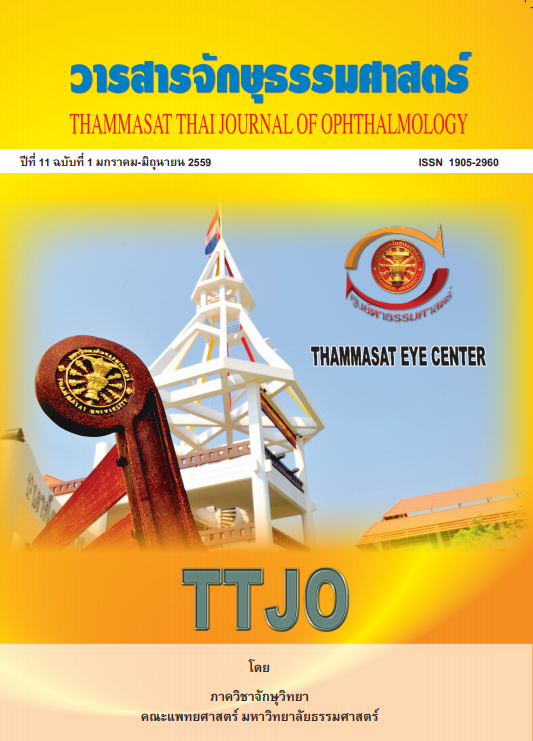การใหแวนเพื่อแกไขสายตาสูงอายุในกลุมประชากรที่มารับบริการ ที่โรงพยาบาลธรรมศาสตรเฉลิมพระเกียรติ
Main Article Content
Abstract
บทคัดยอ วัตถุประสงค: เพื่อใหทราบถึงกําลังของแวนที่ตองเพิ่มขึ้น เพื่อใชในการแกไขสายตาสูงอายุในกลุมประชากร ที่มารับบริการที่โรงพยาบาลธรรมศาสตรเฉลิมพระเกียรติ
รูปแบบการศึกษา: การศึกษาเชิงวิเคราะห ณ เวลาจุดเวลาใดเวลาหนึ่ง
วิธีการศึกษา: ไดทําการศึกษาโดยอาศัยการเก็บขอมูลจากผูที่มารับบริการวัดแวนที่โรงพยาบาลธรรมศาสตร เฉลิมพระเกียรติ ในชวงเดือนมกราคม 2557 – ธันวาคม 2558 ผูเขารวมวิจัยทุกคนไดยินยอมเขารวมงานวิจัย รวมทั้งเก็บขอมูลเรื่องเพศ อายุ ความสามารถในการมองเห็นดีที่สุด (best corrected visual acuity) โรคทาง ตาที่มีผลตอการมองเห็น เชน ตอกระจก ตอหิน รวมไปถึงประวัติผาตัดตามากอน หลังจากนั้นจึงไดทําการ ตรวจประเมินหาคาความสามารถในการเพงโดยการทดสอบใหผูเขารวมวิจัยมองจาก near chart ซึ่งเปนการด ที่ใชวัดสายตาระยะใกล แลวใชเลนสนูนเพิ่มจนผูเขารวมวิจัยสามารถมองเห็นระยะใกลไดระดับ 20/30 ซึ่งเปน ระดับที่สามารถอานหนังสือขนาดมาตรฐานทั่วไป แลวจึงนําขอมูลมาวิเคราะหหาความสัมพันธระหวางอายุที่ เพิ่มขึ้นและคาของแวนที่ตองเพิ่มขึ้น เพื่อใชในการแกไขสายตาสูงอายุ
ผลการศึกษา: จากผูเขารวมวิจัยทั้งสิ้น 243 คน พบวา ชวงอายุที่เริ่มจําเปนตองใชแวนเพื่อแกไขสายตาสูงอายุ เริ่มตนที่อายุ 38 ป โดยเริ่มกําลังของแวนที่เริ่มตนนั้นเริ่มที่ 0.75 ไดออปเตอร ในแตละชวงอายุที่เพิ่มขึ้นนั้น จําเปนตองเพิ่มกําลังของแวนตามเพื่อใหสามารถมองใกลไดชัดเจน อีกทั้ง ผลการวิจัยพบวา ชวงอายุ 36-40 ป คากําลังของแวนเพื่อแกไขสายตาสูงอายุเปน 0.75 ไดออปเตอร, ชวงอายุ 41-45 ป เปน 1.25 ไดออปเตอร, คา ของกําลังแวนเพิ่มขึ้นตามลําดับจนถึงชวงอายุ 76-80 ป
สรุป: จากการศึกษาพบวาประชากรที่มารับบริการที่ รพ. ธรรมศาสตรเฉลิมพระเกียรติ มีความจําเปนตองใช แวนเพื่อแกไขสายตาสูงอายุ เริ่มตนที่อายุ 38 ป โดยเริ่มกําลังของแวนที่เริ่มตนนั้นเริ่มที่ 0.75 ไดออปเตอรและ คากําลังของแวนเพื่อแกไขสายตาสูงอายุนั้นจะคอยๆ เพิ่มขึ้นตามอายุที่เพิ่มขึ้น
Spectacle prescription for presbyopic correction among populations in Thammasat university hospital
Abstract
Objective: To determine the additional power required for presbyopic correction in the population visiting Thammasat university hospital.
Study design: Cross-sectional study
Methods: All patients who had problems with refractive error in Thammasat university hospital during January 2014 to December 2015 were invited in this study. Consent forms were signed by the subjects. Demographic data such as sex, age, best corrected visual acuity, and eye medical history were also collected. Subjective presbyopic correction was performed by adding the plus lens until the subjects can read the short distance Snellen chart to at least 20/30. The correlation between age and adding plus lens was determined.
Results: A total of 243 subjects participated in this study. The age range that patients needed to add the plus to correct presbyopia started from 38 years old. The adding power also started from 0.75 diopters (D). The results showed that the adding of lens increased according to the age of the subjects, such as in the age range 36 – 40 years old, the adding of lens was 0.75 D. During 41 – 45 years old, the adding of lens was 1.5 D. The adding power of lens was increased up to the age range of 76 – 80 years.
Conclusions: Subjects visiting Thammasat university hospital needed to receive presbyopic correction starting from 38 years old. The adding power of lens started from 0.75 D. and increased according to the age of the subjects.
Article Details
References
Petrash JM, Aging and age-related diseases of the ocular lens and vitreous body, Invest Ophthalmol Vis Sci , 2013 Dec 13.13-12940.
Shao Y, Tao A, Jiang H, Mao X, Zhong J, Shen M, Lu F, Xu Z, Karp CL, Wang J, Age-related changes in the anterior segment biometry during accommodation, Invest Ophthalmol Vis Sci. 2015 Jun;56(6):3522-30.
Charman WN, Developments in the correction of presbyopia I: spectacle and contact lenses, OphthalmicPhysiol Opt.2014 Jan;34(1):8-29.
León A, Estrada JM, Rosenfield M , Age and the amplitude of accommodation measured using dynamic retinoscopy , Ophthalmic Physiol Opt. 2016 Jan;36(1):5-12


